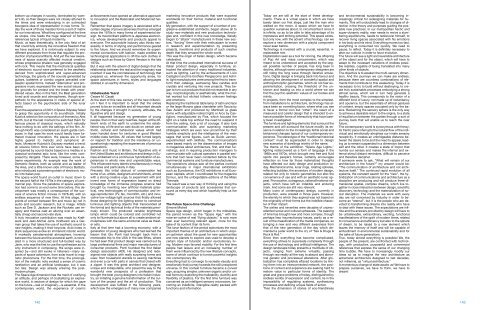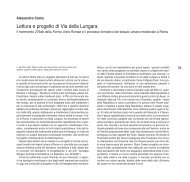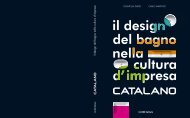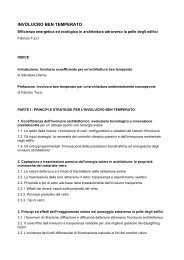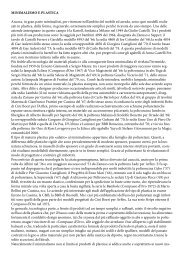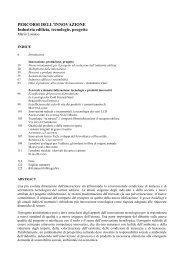SPACE AGE LIGHTS
SPACE AGE LIGHTS
SPACE AGE LIGHTS
Create successful ePaper yourself
Turn your PDF publications into a flip-book with our unique Google optimized e-Paper software.
ottom-up changes in society, dominated by women’s<br />
lib, so their designs were not closely attuned to<br />
the times and were embodying in an outmoded<br />
bourgeois idea of representation in new forms. Today<br />
the work of those masters forms a sort of matrix<br />
for our innovations. What they configured at the time<br />
as utopia, now feeds the huge reservoir of formal<br />
references typical of liquid modernity.<br />
Music, at least theoretically, is the only field of art<br />
that could fully embody the innovative freedom that<br />
we have explored. It is notoriously subject to very<br />
different processes from those that regulate the production<br />
of physical artifacts. And yet the new awareness<br />
of space scarcely affected musical creation,<br />
whose progressive phalanx was generally engaged<br />
with rock. This means that the mechanical qualities<br />
of electronic sound were preferred to the aesthetic<br />
derived from sophisticated and super-advanced<br />
technology, the gravity of the sounds generated by<br />
guitars, batteries or combo organs prevailed over<br />
aseptic spatial forms. Instead “alternative” and progressive<br />
music expressed the new social issues as<br />
the grounds for protest and the break with preordained<br />
values. Also in this field, the Beat generation<br />
loved acid sounds and atmospheres, though sympathetic<br />
to the appearance in clubs of special effects<br />
based on the psychedelic side of the lunar<br />
world.<br />
Even the experience of 2001 A Space Odyssey failed<br />
to grasp this opportunity in its soundtrack. Initially<br />
Kubrick relied on the composition of themes by Alex<br />
North, but at the last moment he switched them for<br />
famous pieces of classical music, which naturally<br />
have nothing to do with the settings of the film. Although<br />
North was considered an avant-garde composer,<br />
in that case his work would hardly have furthered<br />
musical innovation. His pieces are in fact<br />
highly geared to melodic and symphonic effects.<br />
Moreover Kubrick’s Odyssey marked a trend:<br />
all science fiction films ever since have been accompanied<br />
by sound-tracks based on a medley in a<br />
classical-orchestral epic tone, like the ones composed<br />
by Vangelis. There were, however, some extreme<br />
experiments. An example was the work of<br />
Demetrio Stratos, both as soloist and as leader of<br />
the Area, and a little known side of Franco Battiato,<br />
who introduced a pioneering strain of electronic music<br />
into Italian pop.<br />
The space world found an outlet in music down to<br />
the second half of the 1970s in the category of commercial<br />
pop. Since the parabola of space exploration<br />
had come to an end some time before, this development<br />
was mostly a consequence of the success<br />
of science fiction movies in 1978–80, with an<br />
endless sequence of new films. At this stage, the<br />
points of contact between film and music lay not in<br />
audio and acoustic research, but in image. Artists<br />
such as Dee D. Jackson and the Rockets use imagery<br />
and themes cast an alluring over an essentially<br />
cheap and second-rate style.<br />
A truly innovative contribution was made by Kraftwerk<br />
and Jean-Michel Jarre. Kraftwerk are a German<br />
group that takes the use of synthetic sound to<br />
new heights, making it their keynote. Acid notes in<br />
stark sequences evoke an immanent robotic world.<br />
A markedly extraterrestrial atmosphere, hovering<br />
between the future and the ancestral earth, is recreated<br />
in a more structured and full-bodied way by<br />
Jarre, who was the first to use the synthesizer as his<br />
only instrument in composing. His songs were inspired<br />
by—and still evoke in listeners—many aspects<br />
of space adventure, from solar travel to magnetic<br />
phenomena. For the first time, the prolongation<br />
of the metallic note evoked a sense of cosmic<br />
rarefaction and an artificial landscape, but it was<br />
too late. Design was already entering the postmodern<br />
phase.<br />
The Space Age dimension has the merit of codifying<br />
an attitude, and perhaps of crystallizing an expressive<br />
world, in sectors of design for which the gaze<br />
on the future—real or imaginary—is essential. In the<br />
contemporary world, the experience of cosmic<br />
achievements have opened an alternative approach<br />
to innovation and the Rationalist and Modernist heritage.<br />
Remember that space imagery is associated with a<br />
certain degree of provocativeness that has emerged<br />
since the 1970s in many forms of experimental design.<br />
Its most brilliant platform is Japanese electronics,<br />
whose developments and products appeal to<br />
everyone. The automobile industry also thinks necessarily<br />
in terms of styling and performance geared<br />
to the future. And we should remember its experimental<br />
connections with fashion, made credible by<br />
technological applications in off-the-rack clothes in<br />
designs such as those by Gianni Versace in the late<br />
1970s.<br />
But it was with the advent of digital design that the<br />
relationship between the real and the imaginary was<br />
inverted: it was the concreteness of technology that<br />
prepared us, whenever the opportunity arose, for<br />
space adventures in forms, styles and languages<br />
distilled in an earthly dimension.<br />
Unbelievable Years!<br />
Cesare M. Casati<br />
At the start of this new century of the new millennium<br />
I feel it is important to recall that the sixties<br />
proved to be an incredible and all-important decade<br />
by the changes it wrought in society, attitudes, the<br />
figurative arts and design.<br />
It all happened because my generation of young<br />
people, then in their early twenties, began at the different<br />
ends of the earth to undermine the established<br />
way of life and so cast doubt on certain aesthetic,<br />
cultural and behavioral values which had<br />
been handed down for centuries in good Western<br />
middle-class families. All values that turned largely<br />
on respect for tradition and the insistence on unquestioningly<br />
repeating the experiences of previous<br />
generations.<br />
Fashion and music in Britain, the figurative arts in<br />
the United States and architecture and design in Europe<br />
embarked on a continuous hybridization of experiences<br />
in wholly new and unpredictable ways.<br />
This influenced many talents simultaneously in many<br />
countries and particularly in Italy.<br />
Precisely this initial distrust of conservation led<br />
some of us, artists, designers and architects, armed<br />
with a strong creative urge, to experiment with and<br />
invent new forms of expression based on direct<br />
knowledge of the immense progress science had<br />
brought by inventing new artificial materials (plastics),<br />
new technologies of communication and image<br />
reproduction (TV, fax, microfilm, etc.) and innovative<br />
low-voltage light sources that finally allowed<br />
those designing for the lighting sector to construct<br />
luminous and lighting objects that transcended all<br />
the formal and technical limits of the materials previously<br />
known. The produced variable brightness<br />
lamps which could be colored and controlled not<br />
only to illuminate but above all to create ambient atmospheres<br />
with the same emotional value as theater<br />
sets.<br />
Italy at that time had a booming economy, with a<br />
generation of young designers who had learned the<br />
lesson that Gio Ponti had brought back from a<br />
memorable trip to the USA in the late fifties, where<br />
he had seen that product design was carried out by<br />
large professional firms and major manufacturers of<br />
consumer products. Ponti founded the first Italian<br />
design association (ADI). He designed and redesigned<br />
new objects with really surprising forms and<br />
uses: from household utensils to sewing machines<br />
and even a car with parts in canvas that closed with<br />
a zipper. It was this great architect and designer,<br />
unique and indisputable, who paved the way to the<br />
wonderful new prospects of a profession that<br />
brought the best young designers into Italian industry,<br />
so initiating a genuine transformation of the culture<br />
of the project and the art of production. This<br />
development was fulfilled in the following years,<br />
which saw the emergence of many new companies<br />
marketing innovative products that were exported<br />
worldwide for their formal, material and functional<br />
qualities.<br />
My generation, with the support of a number of progressive<br />
established architects, began above all to<br />
study new materials and new production technologies<br />
and, confident in this new knowledge, literally<br />
began to “attack” manufacturers in these new sectors,<br />
“forcing” them with their enthusiasm to invest<br />
in research and experimentation by presenting<br />
projects, inventions and products of such creative<br />
depth that they amazed the whole world.<br />
This was the origin of Italian design, which became<br />
celebrated.<br />
At that time the undoubted international success of<br />
Italian product design, especially in furniture, attracted<br />
the attention of many traditional industries,<br />
such as lighting. Led by the achievements of Livio<br />
Castiglioni and his brothers Piergiacomo and Achille,<br />
light manufacturers were among the first to transform<br />
their catalogs, eschewing fake candles and<br />
crystals and venturing into new projects. They began<br />
to turn out products that did not resemble in any<br />
way, morphologically or aesthetically, what the market<br />
wanted but elicited hitherto unknown feelings<br />
and emotions.<br />
Replacing the traditional table lamp of satin and lace<br />
or the large Murano glass chandelier with Taccia by<br />
Gae Aulenti and produced by Martinelli (a glass<br />
dome with adjustable indirect light) or Arco by Castiglioni,<br />
manufactured by Flos, which focused the<br />
light on a table top without the need to suspend it<br />
from the ceiling, took a lot of courage. It also took<br />
communication skills and surprising marketing<br />
strategies which are even now uncommon by their<br />
humble simplicity and the intelligence of the messages<br />
that some figures, such as Guido Jannon,<br />
experimented with skillfully. The communications<br />
were based mainly on the dissemination of images<br />
in magazines about architecture, first, and then furnishings,<br />
and in requiring production managers to<br />
communicate with cultural operators in parallel sectors<br />
that had never been contacted before by the<br />
commercial systems and furniture manufacturers.<br />
The operations always saw all the parties involved<br />
simultaneously in major international exhibitions<br />
such as Eurodomus, the ICE exhibitions in all European<br />
capitals, which I coordinated for the magazine<br />
Domus, and the unforgettable editions of the Milan<br />
Triennale.<br />
The result was a new way of thinking and using the<br />
landscape of products and accessories that surround<br />
us every day and which hopefully help us live<br />
better.<br />
The Future Space-time Challenge<br />
Simone Micheli<br />
Space Age design, which began in the midsixties,<br />
the period known as the “Space Age,” with the<br />
mise-en-scène of real “flying objects,” is now more<br />
than ever becoming relevant again, more for the<br />
sake of its content than its form.<br />
The lunar fashion of the period epitomizes the most<br />
important themes of an architecture in which utopian<br />
optimism about the quest for new opportunities<br />
and new planets to explore was used to develop a<br />
certain style of futuristic and/or revolutionary living.<br />
Modern man favored mobility. For the first time<br />
people had leisure and an increasing number of<br />
them were influenced by the new lifestyle concepts,<br />
some of which continue to furnish powerful insights<br />
into contemporary life.<br />
Everything had to converge to recreate visually and<br />
emotionally that journey towards the still unexplored<br />
universe. In this context furniture became a curved<br />
sign, acquiring simpler, unknown organic and/or unreal<br />
forms by exploiting the malleability, ductility and<br />
flexibility of plastics. For the first time furniture was<br />
conceived as an intelligent sensory microcosm, becoming<br />
an indefinite, intangible reality packed with<br />
functions and information.<br />
Today we are still at the start of these developments.<br />
There is a virtual space in which we have<br />
barely taken our first steps, just like the man who<br />
walked on the moon. A space which we have to<br />
question ourselves about, to circumscribe it since it<br />
is infinite, so as to be able to take advantage of its<br />
impressive and striking potential. This space exists,<br />
but only now, with the advent of technology, can we<br />
explore a new dimension with a playful component<br />
never seen before.<br />
Technology is invested with a crucial, essential, irreplaceable<br />
role.<br />
Digitalization seen as a tool for cloning, the offspring<br />
of Pop Art and mass consumerism, which was<br />
meant to be understood and accepted by the largest<br />
possible number of people, has long been in<br />
decline, although some contemporary designers are<br />
still riding the long wave through iterative emulations.<br />
Digital design is bringing back into favour and<br />
allowing the development of wonderful spatial and<br />
anthropomorphic geometries, which do not fear experimentation,<br />
crossing the threshold of the unknown<br />
and leading us into a world where we can<br />
find the psychic-aesthetic values of our bodies and<br />
minds.<br />
In projects, from the most complex to the simplest,<br />
from installations to architecture, technology has always<br />
been an overriding factor, where what you see<br />
is never a formal icon but “other”: the result of a<br />
measured and careful design that is intended to enhance<br />
possible forms of interactivity that have barely<br />
been investigated.<br />
The furniture and lighting elements that surround the<br />
present and will surround the future modify its essence<br />
in relation to the increasingly fertile social and<br />
behavioral changes typical of our contemporary experience.<br />
The stereotype of the “traditional historical<br />
context” must be superseded in order to design<br />
new scenarios of dwellings worthy of the name.<br />
The theme of the exhibition “Space Age Lights,”<br />
lighting rediscovered as a form of language in the<br />
1960s and 1970s, which brought new free and fluid<br />
spirits into people’s homes, certainly encourages<br />
reflection on how far those materialized thoughts<br />
have affected our daily design and production today.<br />
Mechanical arms, lunar rings, rotating spheres,<br />
reflecting bubbles, the ancestors of modern design,<br />
related not only to robotic geometries but also the<br />
convenience of use and with an aesthetic-lunar appeal.<br />
Provocative, outrageous, rational/irrational objects,<br />
which have left an indelible and enduring<br />
mark. And some are still very relevant.<br />
Many icons of contemporary design, currently in<br />
production, were created in those years. However,<br />
the eternity to which they aspired was not based on<br />
the originality of their forms but the indelible character<br />
of their impact.<br />
The sixties and seventies were decades of unprecedented<br />
social and cultural upheavals. The passing<br />
of time has brought new and more complex, though<br />
perhaps less insurrectionary issues, partly as a result<br />
of the massification of the media companies, so<br />
bringing a new and very different awareness from<br />
that of the new generation of the day which demanded<br />
a juster world to the cry of “Sex & Drugs &<br />
Rock & Roll.”<br />
Since then everything has become complicated,<br />
everything strives to supersede complexity through<br />
the use of technology and artificial intelligence. The<br />
design landscape today presents a multitude of objects,<br />
ranging from extreme virtuality, passing<br />
through raw reality all the way to absurd and abnormal<br />
genetic and processual alterations. After globalization<br />
has completely effaced localisms by linking<br />
them into an interconnected network, the positions<br />
of content and experience are seeking hard to<br />
restore value to particular forms of identity. The<br />
great and grave problems of today, distinguished by<br />
endless worlds of expression and content, lie in the<br />
impossibility of regulating systems, synthesizing<br />
processes and defining unique fields of action.<br />
Then the dimension of stories of eco-friendliness<br />
and environmental sustainability is becoming increasingly<br />
critical for redesigning materials for humanity.<br />
This will undoubtedly lead to changes of direction<br />
in the theory and purposes guiding the possible<br />
new practices. In our metropolitan hectic and<br />
super-dynamic reality, man needs to revive a slumbering<br />
equilibriums, needs to rediscover himself, to<br />
recover living spaces associated with his emotions<br />
in his body and his mind. Everything moves too fast,<br />
everything is consumed too quickly. We need to<br />
pause, to reflect. Today it is definitely necessary to<br />
alter our outlook in order to favor evolution.<br />
The future will see a light and reversible architecture<br />
of the object and for the object, which will have to<br />
adapt to the incessant variations of endless possible<br />
realities, capable of being translated into many<br />
other kinds of objects.<br />
The objective is to awaken the multi-sensory dimension.<br />
And the journeys we can make are endless,<br />
because there are countless combinations of elements<br />
that contribute to this awakening. Today it is<br />
necessary to try to build without destroying, to create<br />
truly sustainable processes embodying a strong<br />
ethical sense, which will in turn help generate a<br />
healthy beauty. This corresponds to the vision of a<br />
different kind of luxury, not made up of redundancy<br />
and opulence, but the essentials of ethical gestures<br />
of content, empty spaces occupied only by the basics.<br />
Reclaiming the sensory sphere is the only way<br />
to achieve a desirable return to the origins, to a state<br />
of equilibrium between the parties through a sort of<br />
journey back that will enable us to reach the near<br />
future.<br />
The contemporary world is synonymous with frenzy;<br />
its frantic pace interrupts the natural flow of the individual<br />
and emotionally atrophies our innate sensory<br />
receptivity. It creates an unbridgeable distance between<br />
the desire to be and the need to appear, leading<br />
us to remain suspended in a dimension between<br />
self and the other. It creates a state of torpor that<br />
numbs our senses and makes the internal and external<br />
stimuli distant reminders, difficult to perceive<br />
and therefore decipher.<br />
If someone were to ask, “What will remain of our<br />
architecture in the future?” my answer would be:<br />
“The communication of architecture and not architecture<br />
itself.” The continued rapid evolution of all<br />
systems, the constant search for the “new”, the hybridization<br />
of communications and architecture as a<br />
discipline are producing and will produce three-dimensional<br />
spatial, complex dreams, which live together<br />
in close interaction between design, scientific<br />
discovery, technology and the materialization of social<br />
disruption. The materials we work with every<br />
day are not conceived by industry in order to become<br />
an “eternal”, but it is the people who are devoted<br />
to transforming dreams into reality who have<br />
to deal with these issues. The expectations are infinite<br />
and the answers provided by design will have to<br />
be unbelievable, extraordinary, exciting, functional<br />
manifestations of the spirit of modern times, related<br />
to convenience and efficiency but also to the sphere<br />
of dream, to be raised to a new element which<br />
leaves the memory of itself and will be capable of<br />
embodiment in environmental sustainability and for<br />
the sake of future generations.<br />
True, today almost everything is possible! We, the<br />
people of the present, are confronted with technology,<br />
with productive, purposeful and commercial<br />
references that express the sense of our changing<br />
time bubble. We have to increasingly modify our<br />
ideas so as to imagine the new architecture as<br />
ephemeral architecture designed to last decades,<br />
not millennia, as “virtual architecture.”<br />
A momentous change of state awaits us! We have to<br />
prepare ourselves, we have to think, we have to<br />
dream!<br />
142 143


